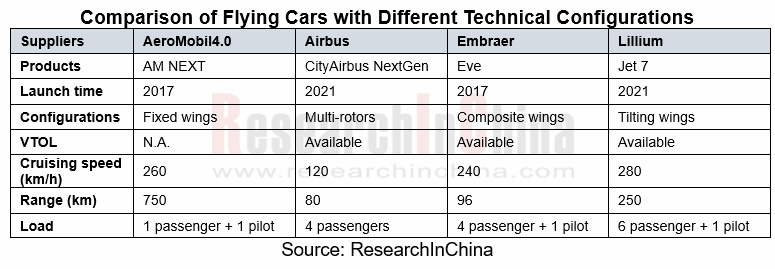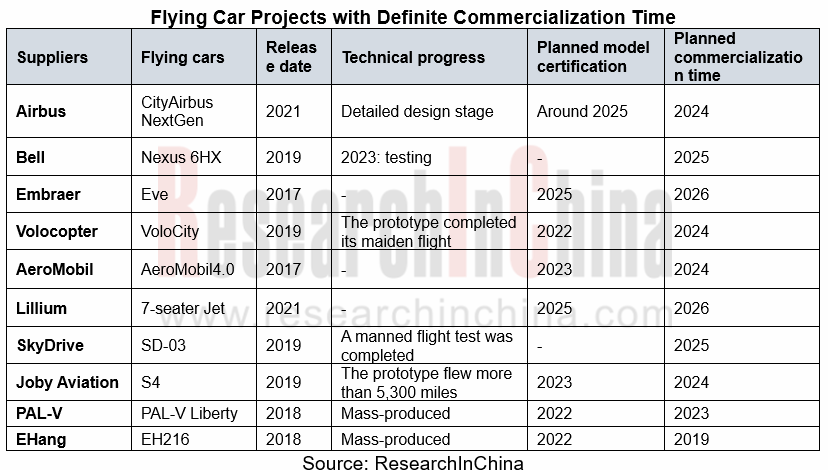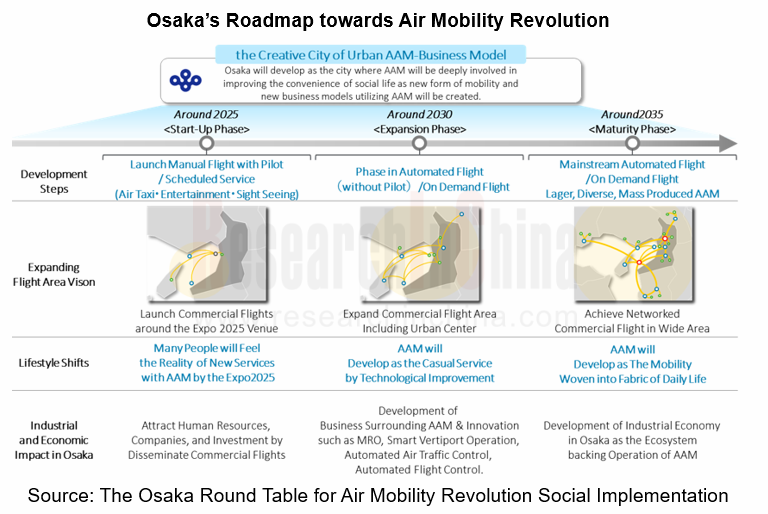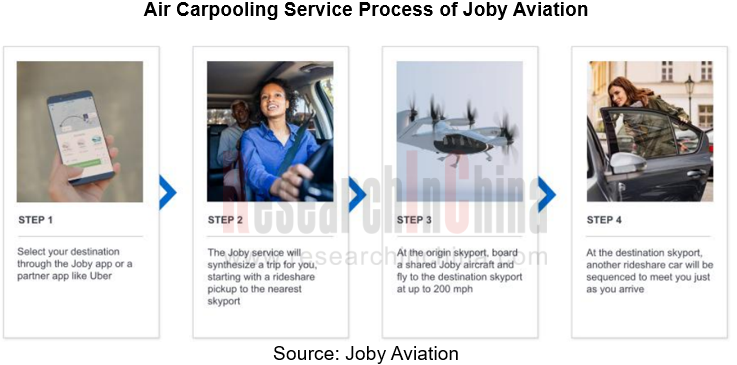ResearchInChina has released “Global and China Flying Car Industry Research Report, 2022".
A flying car is a three-dimensional vehicle. Broadly speaking, it is a low-altitude intelligent autonomous transportation tool carrying cargo or people, namely electric vertical take-off and landing (eVTOL). It features electric vertical take-off and landing, intelligent autonomous driving, amphibious transport and so on.
Multi-rotor configuration is the current mainstream
The technical configurations of flying cars mainly include four types: fixed wings, multi-rotors, composite wings and tilting wings. Among them, the most traditional fixed wings are rarely used due to the inability to take off and land vertically and hover. On the market, the most used multi-rotors take off and land vertically, hover precisely, are simple to operate with little technical difficulty, and land quickly. But, they are only suitable for short-distance transportation because of a short range.
In the future, with the improvement of the route network and the growth of long-distance transportation demand, composite wings and tilting wings with longer range and faster cruising speed will gradually become the mainstream.

Around 2025, flying cars will spring up
As per the planning announced by vendors, the commercialization of flying cars will happen around 2025. By then, the Paris 2024 Summer Olympics and the Expo 2025 Osaka will be in the global spotlight. Therefore, both Paris and Osaka have deployed flying cars.
The city of Paris hopes to create two dedicated flight paths to ferry passengers for the 2024 Olympics and Paralympics. One route will carry passengers via Paris-Charles de Gaulle and Le Bourget airports, while the second will travel between two suburbs southwest of the French capital.
At present, Volocopter and Airbus have commercial plans for the Paris Olympics. Volocopter successfully flew its electric air taxi ‘helicopter’, the VoloCity, from Le Bourget airport in 2021. Also in 2021, Airbus revealed CityAirbus NextGen, an all-electric, four-seat eVTOL multicopter concept featuring a wing, for the general public during the 2024 Olympic Games.

Osaka, Japan has made a very detailed roadmap for the commercialization of flying cars: regular flights will be opened in 2025, routes will be added in 2030, and aircrafts will be larger and diversified in 2035. SkyDrive and Joby Aviation have planned to provide commercial services during the Expo 2025 Osaka (in February 2022, ANA HOLDINGS, INC. and Joby Aviation announced they were forming a partnership that will see Japan's largest airline join with Joby to bring aerial ridesharing services to cities and communities across Japan. Toyota Motor Corporation also joined the partnership).

How do flying cars become possible? The platform operation mode is the prerequisite
Usually, a flying car costs more than USD300,000 (for instance, PAL-V Liberty sells the standard model, known as the Liberty Sport, for USD399,000). As the automation technology is not yet perfect, most eVTOLs require operators with pilot certificates or pilots. Therefore, the platform operation mode is the main business model in the initial stage.
For example, Joby Aviation plans to launch an App-based air ride-sharing service in 2024. Volocopter also plans a complete air carpooling service process, allowing customers to learn about carpooling services through Volocopter website, app, and VoloPort kiosk before placing orders, enjoying services and then evaluating them. In addition, EHang's carpooling service process includes “finding a suitable route in the APP - selecting a destination - selecting an EHang AAV and making a reservation”.

800V High Voltage Platform Research Report, 2023
How to realize the commercialization of 800V will play a crucial part in the strategy of OEMs.
As new energy vehicles and battery technology boom, charging and battery swapping in the new energy vehi...
Automotive Intelligent Cockpit Platform Research Report, 2023
Intelligent cockpit platform research: the boundaries between vehicles and PCs are blurring, and there are several feasible paths for cockpit platforms.
Automotive Intelligent Cockpit Platform Resea...
Global and China Automotive Wireless Communication Module Industry Report,2023
Vehicle communication module research: 5G R16+C-V2X module, smart SiP module and other new products spring up.
In 2022, 4G modules swept 84.3% of the vehicle communication module market....
Intelligent Vehicle Cockpit-Driving Integration Research Report, 2023
Cockpit-Driving Integration Research: many companies are making layout and may implement it during 2024-2025.
1. What is the real cockpit-driving integration?
At present, automotive electroni...
Chinese Joint Venture OEMs' Telematics System and Entertainment Ecosystem Research Report, 2022
Telematics System Research 2: Baidu Family Bucket, Huawei and Tencent Become the Mainstream Ecosystems
ResearchInChina released Chinese Joint Venture OEMs' Telematics System and Entertainment Ecosyst...
China Automotive Digital Key Research Report, 2023
Automotive Digital Key Research: the pace of mobile phones replacing physical keys quickens amid the booming market
"China Automotive Digital Key Research Report, 2023" released by ResearchInChina co...
Automotive Camera Tier2 Suppliers Research Report, 2022-2023
1. The automotive camera market maintains a pattern of "one superpower and several great powers".
Automotive cameras are used to focus the light reflected from the target onto the CIS after refractio...
Emerging Carmaker Strategy Research Report, 2023 - NIO
Emerging carmaker strategy research: NIO is deploying battery swap and sub-brands for the knockout match in 2023.In 2022, the sales surged by 32.3% year on year, being concentrated in first-tier citie...
Nissan CASE (Connectivity, Automation, Sharing and Electrification) Layout Research Report, 2022-2023
Nissan CASE research: two leverages for Dongfeng Nissan to turn the tables. Introduction: since 2020, the declining sales of Dongfeng Nissan have exposed its problems in brand influence and product co...
China Automotive Gesture Interaction Development Research Report,2022-2023
Vehicle gesture interaction research: in 2022, the installations rocketed by 315.6% year on year.China Automotive Gesture Interaction Development Research Report, 2022-2023 released by ResearchInChina...
Automotive Power Management Integrated Circuits (PMIC) Industry Report, 2023
Automotive PMIC research: the process of domestic automotive PMICs replacing foreign ones in China in the “crisis of chip shortage”.
Automotive power management integrated circuits (PMIC) find broad ...
Automotive Cockpit SoC Research Report, 2023
Cockpit SoC research in 2023: Can X86 solutions returning to cockpit SoC challenge the “ARM+Google” mobile solution?
This report highlights the research on the products and plans of 9 overseas and 8 ...
AI Foundation Model and Autonomous Driving Intelligent Computing Center Research Report, 2023
New infrastructures for autonomous driving: AI foundation models and intelligent computing centers are emerging.
In recent years, the boom of artificial intelligence has actuated autonomous driving, ...
Automotive Microcontroller Unit (MCU) Industry Report, 2023
MCU Industry Research: Automotive high-end MCU will be still in short supply, and how OEMs can break the situation.
ResearchInChina has released "Automotive Microcontroller Unit (MCU) Industry Repor...
Global and China Fuel Cell Market and Trend Research Report, 2023
Fuel Cell Industry Research: Hydrogen energy has been put on the national agenda with scenario application being rolled out.The hydrogen energy industry has been included into the national energy stra...
Global and China Automotive Smart Antenna Research Report, 2022-2023
Smart antenna research: the integration of automotive antennas and intelligent connected terminals tends to accelerate.
The development trend of automotive antennas: tend to be intelligent, diversif...
Chinese Independent OEMs’ Telematics System and Entertainment Ecosystem Research Report, 2022
Vehicle telematics system research 1: the control scope is expected to expand to the entire vehicle.From January to December 2022, Chinese independent OEMs installed telematics systems in 6.42 million...
China Autonomous Shuttle Market Report, 2022-2023
Autonomous Shuttle Research: application scenarios further extend amidst policy promotion and continuous exploration
Autonomous shuttles are roughly categorized into minibuses and robobuses. Minibuse...